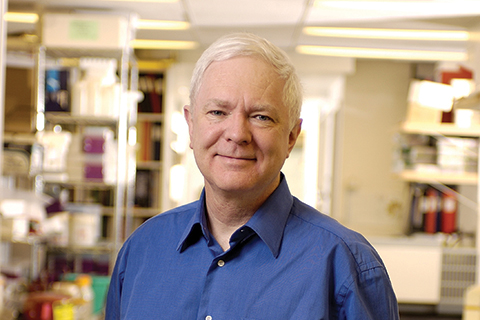Though a man of stellar accomplishments, Tony Pawson was also a dreamer. And therein lay much of his success.
Pawson, who died last August of unspecified causes at age 60, was a true titan of science: the cell biologist won scores of international awards (though the Nobel Prize eluded him, he was nominated fully eight times). He ran his own lab at Mount Sinai Hospital’s Lunenfeld-Tanenbaum Research Institute, and was a professor of molecular genetics at U of T.
“He was a great supporter of curiosity,” says Jim Woodgett, current director of research at the Lunenfeld-Tanenbaum institute. Pawson believed that scientists should be given space and time to follow an educated hunch over a period of years. The journey toward his own big breakthrough began in the 1970s in his native England, and took almost 20 years to pay off.
“The process of scientific discovery is rather like exploring for new continents in the age of sailing ships,” he said in 2008, upon acceptance of Japan’s prestigious Kyoto Prize. Though one must spend a long time adrift, “it is that moment of first seeing the land in the distance, of first realizing that one has a thread of evidence for a new way of looking at the world, that provides the most excitement.”
The “sailing ship” that was Tony Pawson’s career took him from post-doctoral research in California, to teaching microbiology at the University of British Columbia, to his laboratory in Toronto. It docked magnificently in 1990, when he cracked the unique code by which cells communicate with one another, a process known as signal transduction.
Pawson and his team at Mount Sinai observed that a key piece of a cellular protein, known as a domain, could send messages to other cells, thereby controlling their behaviour. They also saw that breakdowns in this messaging system could cause instructions to get scrambled – resulting in harmful cell division, and the onset of diseases such as cancer or Alzheimer’s. Though Pawson worked specifically with a group of proteins known as tyrosine kinases, other types of cells were later discovered to communicate in the same way.
The curing of illness is but one positive outcome of Pawson’s work, affirms Woodgett: “It’s also helping us to understand evolution, among other things.” And in showing how a protein’s “instruction set” can be manipulated, the discovery has led to the development of exciting new cancer drugs such as Gleevec, Herceptin and Avastin. “These are far more targeted than conventional chemotherapy drugs, which cause damage to DNA,” says Woodgett. “Because they’re more specific, they have far fewer side effects.”
Woodgett remembers Pawson as a devoted father and a great friend; a team leader who ably combined enthusiasm with erudition. “Part of his impact was being able to distil information and convert it into a form others could appreciate,” Woodgett says. “It was difficult to come out of a meeting with him without being inspired.”
Watch a biography of Tony Pawson created by the Inamori Foundation, administrators of the Kyoto Prize:
Recent Posts
For Greener Buildings, We Need to Rethink How We Construct Them
To meet its pledge to be carbon neutral by 2050, Canada needs to cut emissions from the construction industry. Architecture prof Kelly Doran has ideas
U of T’s 197th Birthday Quiz
Test your knowledge of all things U of T in honour of the university’s 197th anniversary on March 15!
Are Cold Plunges Good for You?
Research suggests they are, in three ways





